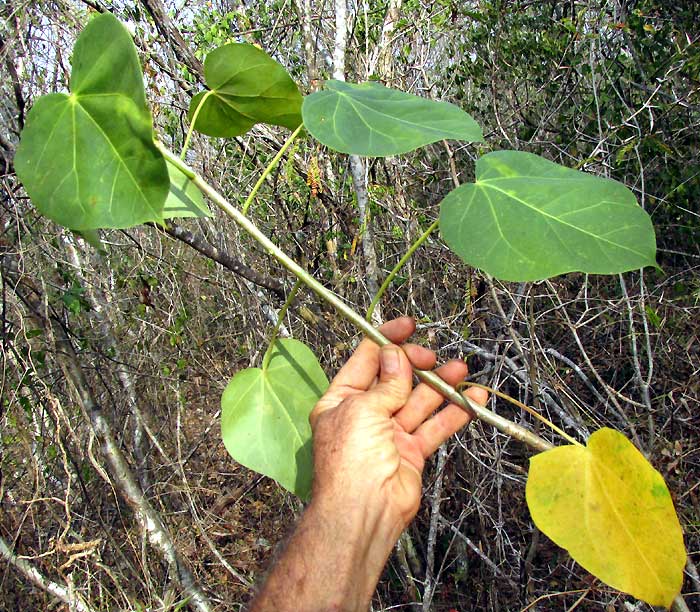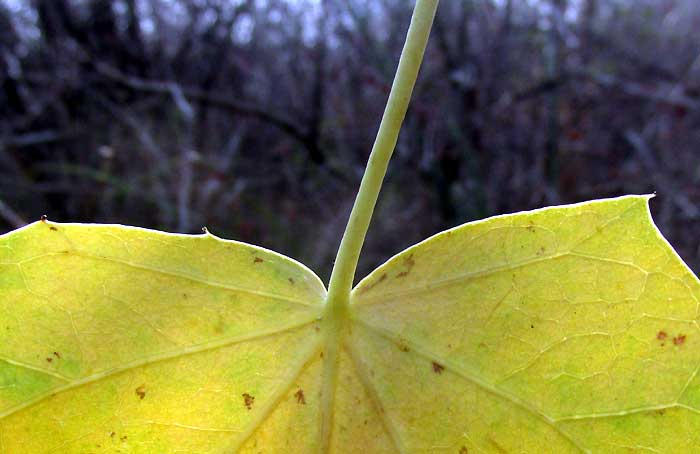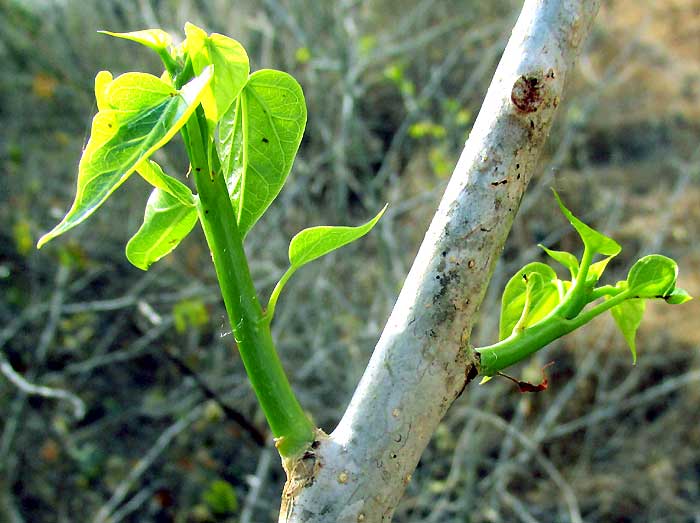Excerpts from Jim Conrad's
Naturalist Newsletter
from the February 15, 2015 Newsletter issued from Río Lagartos, on the Yucatan Peninsula's northern coast (~N21.60°, ~W88.16°), Yucatán state, MÉXICO
POMOL CHÉ
In thin soil atop limestone out in the zone where thorn forest mingles with savanna, a much-branched, thick-stemmed, chest-high shrub catches the eye with its completely leafless, swollen, semi-succulent stems, as shown below:

Even more eye-catching is that many of the grayish stems nowadays bear at their tips small tufts of tiny, delicate looking flowers, as shown below:

There you see male flowers consisting of purplish calyxes enveloping the corollas' bottoms, the corollas themselves with united lobes tinged with pink, and inside the corollas appear clusters of about ten pollen-producing stamens. I couldn't find female flowers, but it's early in the season and maybe later I can show them.
I've seen this combination of features before, especially the unisexual flowers and semisucculent stems, in members of the big Euphorbia or Poinsettia Family, the Euphorbiaceae. Therefore, it didn't take long to figure out that this fairly common shrub is JATROPHA GAUMERI, endemic just to the Yucatan Peninsula south to northern Guatemala. It has no English and maybe no Spanish name, but the Maya are very aware of it, and call it Pomol Ché.
One reason for its fame among the Maya is that -- typical of juicy-stemmed members of the Euphorbia family -- the juice is full of powerful compounds that may be used traditionally as medicine.
In fact, the Maya know to drop Pomol Ché's sap, which is a transparent latex, onto ulcers or open sores, on the body or in the mouth, to promote healing. The latex is also used to clean gums and heal boils and fevers. Taken orally it's used for diarrhea and dysentery, by mixing its sap with that of the similar Jatropha curcas, which also occurs in our area. Children once used the light wood for making whistles, and its leaves were substituted for banana leaves when patting corn paste into tortillas.
Issued April 13, 2020 from Tepakán, Yucatán, MÉXICO
MORE PICTURES
In the rancho's regenerating thornforest, Jatropha gaumeri is common and conspicuous. Here are more pictures to round out the species' profile. First, after weeks of extremely hot, dry wind with no rain, most woody plants are leafless, and herbaceous plants are dead or nearly so. However, at a neighbor's rancho, Jatropha gaumeri not only has been ignored by grazing cattle, but also looks as shown below:

Most Jatropha gaumeri bushes in the rancho's forests are leafless, but some still bear last season's leaves, shown below:

Leaf bases usually bear two or three gland-tipped teeth, shown below:

The stems are fairly thick and succulent. Many that lost their leaves weeks ago now are sprouting, shown below:

Breaking off a leaf or a stem tip causes several drops of cloudy sap to form, shown below:

Issued May 28, 2020 from Tepakán, Yucatán, MÉXICO
POMOL CHÉ CAPSULES
Nowadays Pomol Ché is producing the capsules shown below:

Some larger trees still bear last season's panicle of opened, seedless capsules, shown below:

In the Euphorbia Family, most fruits are three- or more-lobed capsules that split elastically from a persistent axis. That design can be discovered in the topmost fruit-remains in the above picture. A close-up of such a fruit-remains is shown below:

The three "wings" are the capsule's sides held aloft by slender stalks that apparently sprang up elastically, maybe tossing seeds out, when the capsule was well mature and dry.